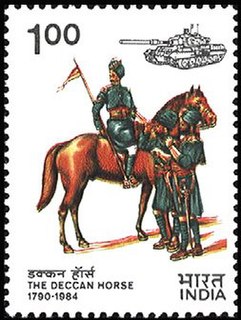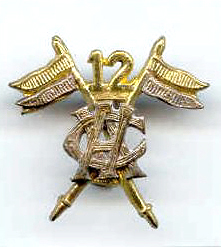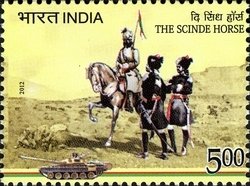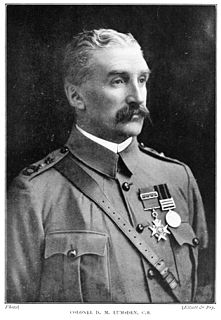 W
WThe 1st Horse is a regiment of the Armoured Corps of the Indian Army. It traces its origins as a cavalry regiment from the times of the East India Company, followed by its service in the British Indian Army and finally, after independence as the fourth oldest and one of the senior cavalry regiments of the Armoured Corps of the Indian Army.
 W
WThe 2nd Lancers is one of the oldest and a highly decorated armoured regiment of the Indian Army. The regiment was formed by the amalgamation of two of the oldest regiments of the Bengal Army – the 2nd Royal Lancers and the 4th Cavalry.
 W
WThe 3rd Cavalry Regiment is a cavalry regiment of the Indian Army formed from the 5th and 8th Cavalry regiments in 1922.
 W
WThe 4th Cavalry was a cavalry regiment of the British Indian Army.
 W
W4th Horse is a part of the Armoured Corps of the Indian Army, which had its beginnings as an irregular cavalry regiment during the time of the Indian Rebellion of 1857.
 W
WThe 5th Horse is an armoured regiment of the Pakistan Army. It was previously known as the 5th King Edward's Own Probyn's Horse, which was a regular cavalry regiment of the British Indian Army. It was formed in 1921 by the amalgamation of the 11th King Edward's Own Lancers and the 12th Cavalry.
 W
WThe 6th Lancers is an armoured regiment of the Pakistan Army. Previously, it was known as the 6th Duke of Connaught's Own Lancers , and was a regular cavalry regiment in the British Indian Army. It was formed in 1921 by amalgamation of the 13th Duke of Connaught's Lancers and the 16th Cavalry. The regiment and its predecessors have seen active service on the North West Frontier, in Egypt during 1882, in China during the Boxer Rebellion, the two World Wars and the Indo-Pakistani War of 1965. On the Partition of India in 1947, the regiment was allotted to the Pakistan Army, where it remains in service today.
 W
WThe 8th Light Cavalry traces its origins from the 8th King George's Own Light Cavalry which was formed in 1922 by the amalgamation of the 26th King George's Own Light Cavalry and the 30th Lancers following a re-organisation of the Indian Cavalry Corps. Both regiments were regular cavalry units that had had long and distinguished records in the British Indian Army prior to their amalgamation. During World War II the regiment was converted into an armoured car unit and served during the Burma campaign. After India gained Independence the regiment was named 8th Light Cavalry.The regiment is the third oldest armoured regiment in India and is amongst the most highly decorated regiments in the country.
 W
WThe Deccan Horse or 9 Horse is one of the oldest and most decorated armoured regiments of the Indian Army. The The Royal Deccan Horse , which was a regular cavalry regiment of the British Indian Army was formed from the amalgamation of two regiments after World War I. They saw service from the Mutiny of 1857 up to and including World War II.
 W
WThe 11th Cavalry , is an armoured regiment of the Pakistan Army. It was previously known as the 11th Prince Albert Victor's Own Cavalry and was a regular cavalry regiment of the old British Indian Army. It was formed in 1921 by the amalgamation of the 21st Prince Albert Victor’s Own Cavalry and the 23rd Cavalry.
 W
WThe 5th Horse is an armoured regiment of the Pakistan Army. It was previously known as the 5th King Edward's Own Probyn's Horse, which was a regular cavalry regiment of the British Indian Army. It was formed in 1921 by the amalgamation of the 11th King Edward's Own Lancers and the 12th Cavalry.
 W
WThe 5th Horse is an armoured regiment of the Pakistan Army. It was previously known as the 5th King Edward's Own Probyn's Horse, which was a regular cavalry regiment of the British Indian Army. It was formed in 1921 by the amalgamation of the 11th King Edward's Own Lancers and the 12th Cavalry.
 W
WThe 12th Cavalry is an armoured regiment of Pakistan Army. It was formed in the British Indian army in 1922 by the amalgamation of 22nd Sam Browne's Cavalry and 25th Cavalry.
 W
WThe 6th Lancers is an armoured regiment of the Pakistan Army. Previously, it was known as the 6th Duke of Connaught's Own Lancers , and was a regular cavalry regiment in the British Indian Army. It was formed in 1921 by amalgamation of the 13th Duke of Connaught's Lancers and the 16th Cavalry. The regiment and its predecessors have seen active service on the North West Frontier, in Egypt during 1882, in China during the Boxer Rebellion, the two World Wars and the Indo-Pakistani War of 1965. On the Partition of India in 1947, the regiment was allotted to the Pakistan Army, where it remains in service today.
 W
WThe 13th Lancers is an armoured regiment of Pakistan Army. It was formed in 1923 as 13th Duke of Connaught's Own Lancers by the amalgamation of 31st Duke of Connaught's Own Lancers and 32nd Lancers. On Partition of India in 1947, the regiment was allotted to Pakistan.
 W
WThe 13th Lancers is an armoured regiment of Pakistan Army. It was formed in 1923 as 13th Duke of Connaught's Own Lancers by the amalgamation of 31st Duke of Connaught's Own Lancers and 32nd Lancers. On Partition of India in 1947, the regiment was allotted to Pakistan.
 W
WThe 14 Horse is an armoured regiment in the Armoured Corps of the Indian Army. The regiment, known before independence as the 14th Prince of Wales's Own Scinde Horse was a regular cavalry regiment of the Bombay Army, and later the British Indian Army.
 W
WThe 14th Murray's Jat Lancers, also sometimes known as the Murray's Jat Horse, was a cavalry regiment of the British Indian Army.
 W
WThe 15th Lancers (Baloch) is an armoured regiment of the Pakistan Army. It was formed in 1922 by the amalgamation of the 17th Cavalry and the 37th Lancers.
 W
WThe 15th Lancers was a cavalry regiment of the British Indian Army which existed from 1858 to 1921. Raised during the 1857 uprising, the regiment later saw service in the Second Afghan War of 1878–80 and the First World War. The regiment was one of the single class regiments, with all troops being recruited from the Multani Seraiki Muslim community.
 W
WThe 16th Light Cavalry is a regiment of the Armoured Corps, a primary combat arm of the Indian Army. Prior to India gaining independence from the British in 1947, it was a regular cavalry regiment of the British Indian Army. It was formed in 1776 and is the oldest armoured regiment raised in India. The 16th Light Cavalry saw service in a number of conflicts ranging from the Second Anglo-Mysore War in 1781 to World War II. It has a number of battle honours including "Punjab 1965" earned during the Indo-Pakistani War of 1965.
 W
WThe 19th Lancers is an armoured regiment of the Pakistan Army. Before 1956, it was known as 19th King George V's Own Lancers, which was a regular cavalry regiment of the British Indian Army. It was formed in 1922, by the amalgamation of 18th King George's Own Lancers and 19th Lancers . On Partition of India in 1947, the regiment was allotted to Pakistan.
 W
WThe 20th Lancers was a regiment of the British Indian Army.
 W
WThe 20th Lancers is an armoured regiment of the Pakistan Army.
 W
WThe 36th Jacob's Horse were a unit of cavalry of the British Indian Army.
 W
WThe Central India Horse was a regular cavalry regiment of the British Indian Army and is presently part of the Indian Army Armoured Corps.
 W
WThe Governor General's Bodyguard was a cavalry regiment of the British Indian Army. The regiment was, in effect, the Indian equivalent of the Household Cavalry of the British Army.
 W
WThe Guides Cavalry is an armoured regiment of the Pakistan Army which was raised in 1846 as The Corps of Guides. During more than a hundred and fifty years of military service, the regiment has earned the reputation of one of the most renowned military units in the world.
 W
WLumsden's Horse, also known as Colonel Lumsden's Corps, was the name given to the Indian Mounted Infantry Corps, which was formed in Calcutta in 1899 by Lieutenant-Colonel Dugald McTavish Lumsden of the Assam Valley Light Horse. The new corps was raised from volunteers from various existing Indian regiments, including the Assam Valley Light Horse. Colonel Lumsden contributed 50,000 rupees.
 W
WThe Poona Horse is an armoured regiment in the Armoured Corps of the Indian Army. The regiment, known before independence as The Poona Horse, was raised as a regular cavalry regiment in the Bombay Presidency army of the East India Company. It was formed from the 3rd Regiment of Bombay Light Cavalry, raised in 1820, and the Poona Auxiliary Horse, raised about 1817–18. The latter unit was absorbed into the regular forces about 1860 and the two regiments later became the 33rd Queen Victoria's Own Light Cavalry and the 34th Prince Albert Victor's Own Poona Horse.